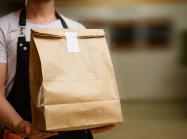The company, currently partnered with nearly 300 restaurants in Florida, pays drivers between $20 and $30 and is projected to make a profit.
For many restaurants, delivery has become a much larger business over the past three years, but not necessarily by choice.
Aggregators like DoorDash, Grubhub, Uber Eats, and Postmates were growing at a healthy clip before COVID arrived, but the pandemic accelerated changes. Customers—either by law or fear of picking up the virus—kept inside their homes. Delivery became a preferred method, and restaurants quickly adapted to this shifting behavior.
That’s where tension arose. As more operators partnered with third-party delivery companies, complaints around high delivery fees, spoof numbers and imposter websites, and a lack of transparency spread across the country. Lawsuits popped up in multiple metro markets, including San Francisco, Chicago, and New York. City councils passed artificial caps on delivery fees by aggregators.
The food delivery market is worth over $150 billion globally, according to McKinsey & Company, more than tripling 2017. In the U.S. specifically, it’s more than doubled during the pandemic, after steady growth of 8 percent.
Greg Bourassa and Steven Weed, both with heavy backgrounds in the food and beverage space, recognized this struggle among operators, and sought to find an alternative.
“It was to the point where the restaurants weren't making any money on their deliveries,” Weed says. “In fact, they were going into the hole. I mean you take a $30 order and you charge the restaurant 30 percent of that order, plus you add on another 15 percent on the menu items and you charge the customers $5 to $7. It ended up where the restaurateur made no money. The margins in the restaurant business are very thin and they were paying like $12 just to deliver $30 for a couple of hamburgers and fries or a couple of pizzas.”
The duo’s delivery startup, named Ungry Brands, operates similarly to the large aggregators. A customer searches for their desired food on the website/app, a restaurant is selected and a meal is ordered, the location receives information on a tablet, food is prepared, and then the delivery driver picks it up for transport to the guest. There are apps available for restaurant managers, delivery drivers, and customers.
The biggest difference is, Ungry Brands charges a flat fee of $2.95 for every order, no matter the cost. The company also doesn’t increase menu prices on its platform. Drivers are paid between $20 to $30 per hour, coming from 100 percent of a separate delivery fee (the cost to get the order from the restaurant to consumer), and 100 percent of tips. Funds are deposited into restaurant accounts every three to five days and drivers can receive money either weekly or ahead of time. After paying restaurants, drivers, Apple and Google’s app store fee, and an area licensee, Ungry Brands is left with $2 per order to cover expenses.
The company is currently based in Florida’s Panhandle, Space Coast, and Treasure Coast, and partnered with close to 300 restaurants, many of which are near college towns like Gainesville and Tallahassee. The Ungry Brands app can only be accessed regionally. For now, online ordering is completed through omniverseorders.com, but this backend digital infrastructure will soon be available on Ungry Brand’s frontend website. The technology is powered by roughly 50 programmers and software engineers based overseas.
Unlike the bigger delivery companies, Weed and Bourassa believe their company can turn a profit because of lower overhead. For perspective, DoorDash recently laid off 1,250 workers, or about 6 percent of the brand’s workforce. The delivery company reported $1.7 billion in revenue in Q3, but net loss skyrocketed from $101 million to $296 million year-over-year. Neil Saunders, managing director of GlobalData, told the Associated Press that DoorDash is losing about 70 cents per order, compared to losing 41 cents per order at the start of 2022.
For Ungry Brands, looking at an assumption of 1,000 participating restaurants, 300 deliveries per month from each location (3.6 million over a years’ time), and the $2 received from each delivery, it estimates $7.2 million in revenue per year. Under the same scenario, their annual expenses would be listed as rent, $60,000; salaries, $360,000; marketing, $720,000; delivery driver recruiting fees, $520,000; and miscellaneous, $180,000. That would put total costs at $1.84 million, meaning a profit of $5.36 million before taxes.
Ungry Brands is projected to reach that 1,000-restaurant benchmark by Q4 2023. There have been discussions with food distributors that service between 12,0000 and 200,000 restaurants and chains between 1,000 and 5,000 units. Ungry Brands hopes to have at least once of these concepts signed, which would significantly alter their projections.
“We figured we could get our overhead down to very manageable numbers and implement and develop our technology so that, believe it or not, we can reduce all those costs that the big guys charge down to practically nothing—$2.95 flat fee for delivery,” Weed says.
The company says it will grow its partner restaurants organically with the use of an offshore telemarketing firm. There are no costs for restaurants to sign up. Ungry Brands is attracting consumers primarily through social media advertisements, like Facebook and Instagram. It’s also planning on setting up kiosks on college campuses to build awareness. Weed and Bourassa foresee larger growth in Florida first, and then to adjacent markets in Georgia, Alabama, Mississippi, and the Carolinas. These will also be close to universities to maximize business, like Ole Miss in Oxford, Mississippi, or Mississippi State in Starkville. Weed says Ungry Brands won’t have to open offices in the further-out places; all of the setup can be done remotely.
Weed and Bourassa are both confident in Ungry Brands’ ability to keep expenses down as it scales to more regions and adds more restaurant and drivers.
“Greg is more or less the technical officer, and I'm the operations guy,” Weed says. “I'll be watching it like a hawk. And we're very good at coming up with solutions to problems. And there will be problems in terms of overhead. And we'll solve those problems as they arise. We don't expect to just let it grow like weeds in your yard. It'll be exceedingly well-managed growth.”
“ …. Once restaurants see that they can put a couple extra $1,000 in their pocket every month, the restaurants are happy, the customers are happy, the drivers are happy and this thing's going to take off like a forest fire,” he says.




%20(1)_099fe.png)











